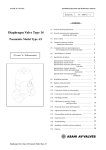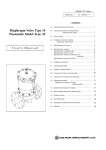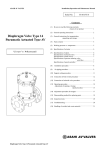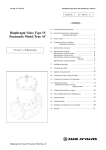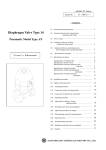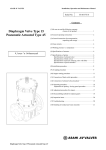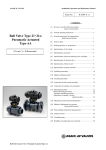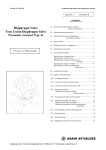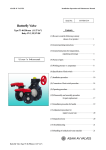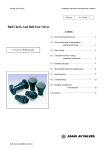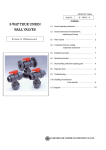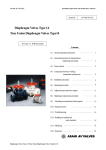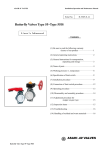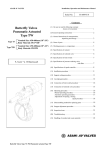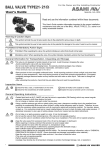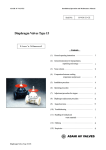Download Diaphragm Valve Type 14
Transcript
ASAHI AV Valves
Serial No.
H – A007 E – 2
Contents
Diaphragm Valve Type 14
Pneumatic Model Type AN
(1)
General operating instructions
1
(2)
General instructions for transportation,
unpacking and storage
1
(3) Name of parts
2
(4) Comparison between working
temperature and pressure
3
(5)
(6)
Comparison between operating pressure
and working pressure and opening degree
Specifications of actuator
5
5
User ’s Manual
(7)
Specification of options
Specifications of solenoid valve
Specifications of limit switch
Specifications of pressure reducing valve
with filter
Specifications of speed controller
Specifications of fully open adjustment
mechanism
Specifications of manual operating
mechanism
6
6
7
7
8
8
8
(8)
Installation procedure
9
(9)
Support setting procedure
13
(10)
Air piping procedure
14
(11)
Connection of limit switch procedure
16
(12) Connection of solenoid valve procedure
17
(13)
Operating procedure
18
(14)
Adjustment of opening / closing
speed procedure
19
(15)
Mounting insert-metal and base(panel)
21
(16)
Adjustment procedure for stopper
22
(17)
Disassembling method for replacing parts
24
(18)
Inspection items
26
(19)
Troubleshooting and action
25
(20)
Handling of residual and waste materials
27
(21) Inquiries
- 0 -
27
(1) General operating instruction
○ Operate the valve within the range of the published working temperature and pressure.
(The valve can be damaged by operation beyond the maximum allowable range of temperature vs. pressure.)
○ To select a valve in appropriate materials, refer to “CHEMICAL RESISTANCE ON ASAHI AV VALVE”.
(Some chemicals give heavy damage to valve materials.)
40 torque should be checked before installation, as they may become loose after long-term storage. A
○ Bolt ◯
periodic check of the valve condition as well as bonnet & flange bolt torque should be made part of preventative
maintenance program properly re-tightening the bolts as necessary. It is especially important to re-tighten all
bolts during the first shutdown, refer to installation on page 24.
○ Do not disassemble the actuator. (Injury may occur.)
○ The valve is not designed to bear any kind of external load. Never stand on or place anything heavy on the valve.
○ Do not put added weight on the AV valve. (AV valve will break.)
○ When the valve is disposed of, contact waste disposal specialist. (The valve generates toxic gas.)
○ The valve should be installed at place where space for periodic inspection & maintenance is sufficient.
○ Do not store or install the valve near any heat source or hot surface.
○ Set valve support on the valve. (Refer to page 13)
○ Keep the valve away from places of direct sunlight, water and dust. Use cover to shield the valve.
(The valve will not operate properly.)
○ Do not use AV valves in a place where they may become submerged in water.
(Submergence will make AV valve fail.)
(2) General instructions for transportation, unpacking and storage
○ Keep the valve in its original packaging until needed for installation.
○ Avoid contact with any coal tar creosote, insecticides, vermicides or paint.
(The force of swelling may damage the valve.)
○ The valve is not designed to handle any kind of impact. Avoid throwing or dropping the valve.
○ Avoid scratching the valve with any sharp object.
- 1 -
(3) Name of parts
No.
1
◯
3
◯
3a
◯
4
◯
5
◯
6
◯
7
◯
11
◯
14
◯
21
◯
DESCRIPTION
Body
Diaphragm
Inserted metal of diaphragm
No.
24
◯
Cushion
Cushion cover
25e
Compressor
Joint
Gauge cover
O-ring(A)
Screw
25b
25c
26
◯
27
◯
28
◯
29
◯
30
◯
33
◯
DESCRIPTION
Ensat (insert metal)
End connector(Socket end type)
End connector(Threaded end type)
End connector(Spigot end type)
Union nut
O-ring(C)
Actuator(double acting)
Actuator(air to shut)
Actuator(air to open)
Compressor pushing plate
- 2 -
No.
40
◯
41
◯
43
◯
52
◯
53
◯
54
◯
55
◯
56
◯
DESCRIPTION
Bolt(B)
Indicative rod
Stopper
Manual shaft
Thrust ring
Rod for travel stop
Fitting for travel stop
Bolt &nut
(4) Comparison between working temperature and pressure
- 3 -
Caution
Do not operate the valve beyond the range of working temperature and pressure.
(The valve can be damaged.)
- 4 -
(5) Comparison between operating pressure and working pressure and opening degree
(6) Specifications of Actuator
15mm, 20mm
(1/2”, 3/4”)
Nominal size
Operating pressure
MPa{kgf/cm2}[PSI]
Air consumption,
Nl/per [inch3]
1 opening of closing
(0.4MPa)
Air supply orifice
Double acting , Air
to open,
Air to shut
25mm, 32mm
(1”, 1 1/4”)
40mm
(1 1/2”)
50mm
(2”)
0.4-0.6 {4.1-6.1} [57-85]
Double acting
2.6 [160]
2.7 [170]
9.6 [590]
9.8 [600]
Air to open
0.8 [49]
0.8 [49]
3.4 [210]
3.4 [210]
Air to shut
1.8 [110]
1.9 [120]
6.1 [370]
6.3 [380]
Double acting , Air
to open,
Air to shut
Rc 1/4
- 5 -
(7) Specifications of Options
(Specifications of Solenoid valve)
Actuation
Nom.
Size
All type
15mm
(1/2”)50mm
(2”)
Model No.
Pipe bore
Effective cross
section area
mm2(inch2)
Power
consumption
Additional function
O Bypass valve built – in
4N3S102K-W□
-G31193
Rc 1/4
10(0.016)
or more
AC ; 6VA
O Silencer with needle
DC ; 5.5W
Valve attached
(to be used as speed controller)
4N3S102K-W□-G31193
* ( )is special order.
connection diagram Specification
sign
AC100V 50/60Hz
1
AC110V 50/60Hz
(2)
AC200V 50/60Hz
3
AC220V 50/60Hz
(4)
DC24V
5
DC48V
(6)
DC100V
(7)
DC125V
(9)
JIS sign
- 6 -
(Specifications of limit switch)
Actuation
Nominal size
Type sign
Protection grade
Double acting , Air to
open,
Air to shut
15mm-50mm
(1/2” - 2”)
1LS19-J
Equivalent to IP55
Limit switch rating Rate voltage
(V)
connection diagram
resistive load
(A)
Inductive load
(A)
AC125
11
7
AC250
11
7
DC125
0.5
0.1
DC250
0.25
0.04
(At intermediate opening)
(Specification of pressure reducing valve with filter)
Actuation
Nom. Size
Type sign
Pipe bore
Element degree of
filtration
All type
15mm-50mm
(1/2” - 2”)
ARU2-02-8A-B
Rc 1/4
5μm
JIS sign
- 7 -
(Specification of speed controller)
Actuation
Nom. Size
Type sign
Pipe bore
All type
15mm-50mm
(1/2” - 2”)
SC7-08A
Rc 1/4
Effective cross section area
mm2(inch2)
Free flow
Control flow
11(0.017)
8.3(0.013)
JIS sign
(Specifications of fully open adjustment mechanism)
As to the block diaphragm and adjusting method, refer to pages 2 and 22, respectively.
(Specifications of manual operating mechanism (set only at air to open))
As to the block diaphragm and operating method , refer to pages 2 and 23, respectively.
- 8 -
Needle No. of
revolution
8 turns
(8) Installation procedure
Necessary items
● Torque wrench
● Spanner wrench
● Bolt, Nut, Washer (For many flanges specification)
● AV gasket
(When a non-AV gasket is used, a different tightening torque instruction should be followed.)
Procedure
1) Set the AV gasket between the flanges.
2) Insert washers and bolts from the pipe side, insert washers and nuts from the valve side, then
temporarily tighten them by hand.
Caution
The parallelism and axial misalignment of the flange surface should be below the values in the following
(A failure to observe them can cause destruction due to stress application to the pipe)
Unit : mm (inch)
Nom. Size
15mm-32mm
(1/2” - 1 1/4”)
40mm, 50mm
(1 1/2” - 2”)
Axial
Misalignment
Parallelism
(a-b)
1.0 (0.04)
0.5 (0.02)
1.0 (0.04)
0.8 (0.03)
(Axial misalignment)
(Parallelism)
3) Using a torque wrench, tighten the bolts and nuts gradually to the specified torque in a diagonal manner.
(Refer to fig.1.)
Specified torque value
Nom. Size
Torque value
15mm, 20mm
(1/2”, 3/4”)
17.5{179}[155]
Unit : N-m {kgf-cm} [lb-inch]
25mm - 40mm
50 mm
(1” - 1 1/2”)
(2”)
20.0{204}[177]
22.5{230}[200]
Fig. 1
Caution
Avoid excessive tightening. (The valve can be damaged.)
- 9 -
Threaded type
(Material : PVC, C-PVC, PP, PVDF)
Necessary items
● Sealing tape (A non-sealing tape can cause leakage.)
● Strap wrench (Do not use Pipe wrench.)
● Spanner wrench
Caution
Make sure that threaded connections are plastic x plastic.
(Metallic thread might damage the body cap)
Procedure
1) Wind a sealing tape around the external thread of joint, leaving the end (about 3mm) free.
26 with a strap wrench.
2) Loosen the union nut ◯
26 and the end connector 25c .
3) Remove the union nut ◯
26 through the pipe.
4) Lead the union nut ◯
5) Tighten up the external thread of the joint and the end connector
25c hardly with hand.
6) Using a spanner wrench, screw in the end connector 25c by turning 180° -360° carefully without damaging it.
Caution
Avoid excessive tightening. (The valve can be damaged.)
27 is mounted.
7) Make sure that the O-ring (C) ◯
26 directly on the body without allowing the O-ring (C) ◯
27 to
8) Set the end connector 25c and union nut ◯
come off.
26 hardly with hand.
9) Tighten up the union nut ◯
10) Using a strap wrench, screw it in by turning 90° - 180° carefully without damaging it.
Caution
Avoid excessive tightening. (The valve can be damaged)
- 10 -
Socket type (Material : PVC, C-PVC)
Necessary items
● PVC or C-PVC cement (Adhesive for vinyl chloride pipes)
● Strap wrench
Caution
Do not install a socket type valve where the atmospheric temperature is 5 °C (23 °F) or lower.
(The valve joint can fail.)
Procedure
26 with a strap wrench.
1) Loosen the union nut ◯
26 and end connector 25b .
2) Remove the union nut ◯
3) Lead the union nut through the pipe.
4) Make sure the hub part of the end connector 25b is clean with waste cloth.
5) Apply adhesive evenly to the hub part of the end connector 25b and the pipe spigot.
Caution
Do not apply more adhesive than necessary.
(The valve can be damaged due to solvent cracking.)
Adhesive Quantity (guideline)
15mm 20mm
Nom. Size
(1/2”) (3/4”)
Quantity(g)
1.0
25mm
(1”)
32mm
(1 1/4”)
40mm
(1 1/2”)
50mm
(2”)
2.0
2.4
3.5
4.8
1.3
6) After applying adhesive, insert the pipe quickly to the end connector 25b and leave it alone for at least 60
seconds.
7) Wipe away overflowing adhesive.
27 is mounted
8) Make sure that O-ring(C) ◯
26 directly on the body without allowing the O-ring(C) ◯
27 to come off.
9) Set the end connector 25b and union nut ◯
26 hardly with hand.
10) Tighten up the union nut ◯
11) Using a strap wrench, tighten the union nut an additional 90° - 180° carefully without damaging it.
Caution
Avoid excessive tightening. (The valve can be damaged.)
- 11 -
Socket type (Material : PP, PVDF )
Spigot type (Material : PP, PVDF)
Necessary items
● Strap wrench (Do not use the pipe wrench.)
● Sleeve welder or automatic welding machine
● User’s manual for sleeve welder or automatic welding machine
Procedure
1) Loosen the union nut with a strap wrench.
26 and the end connector.
2) Remove the union nut ◯
26 through the pipe.
3) Lead the union nut ◯
4) For the next step, refer to the user’s manual for the sleeve welder or the automatic welding machine.
27 t is mounted.
5) After welding, make sure that the O-ring (C) ◯
26 directly without allowing the O-ring (C) ◯
27 to come off.
6) Set the end connector 25b , 25e and the union nut ◯
26 hardly with hand.
7) Tighten up the union nut ◯
8) Using a strap wrench, tighten the union nut an additional 90° - 180° carefully without damaging it
Caution
Avoid excessive tightening. (The valve can be damaged.)
- 12 -
(9) Support Setting Procedure
Necessary items
● Spanner wrench
● U-type clamp (with bolt)
Caution
Set the valve support.
(The valve may be damaged because the actuator is heavy.)
Do not subject the valve pump vibrations.
(The valve may be damaged.)
Level plumber
○ Using metal insert(Ensert) & U-type clamp
Fix the installation jig (under the valve) and stand
with bolts (Refer to page 21)
Spread the rubber sheet on the pipe and secure pipe
with U-type clamp.
○ Using U-type clamp (Only Flanged type)
Spread the rubber sheet on the pipe and secure pipe
with U-type clamp.
Perpendicular plumber
Fix the installation jig (under the valve) and stand with
bolts (Refer to page 22)
Spread the rubber sheet on the pipe and secure pipe with
U-type clamp.
- 13 -
● Rubber sheet
(10) Air Piping procedure
<1> For a standard type and an attached speed controller type
Necessary items
● Spanner wrench
● Steel pipe or tube for piping
● Sealing tape (If seal tape isn’t used, leakage may be caused)
● Joint for steel pipe or tube
Caution
Use compressed air as operating fluid. Don’t use oil pressure and water pressure.
(Actuator may be damaged.)
Use clean, filtered compressed air.
(Actuator may not work normally.)
When a steel pipe is used for piping, use the pipe the inside of which is treated to be rust preventive.
(The intrusion of rust into the actuator the electromagnetic valve may cause a malfunction.)
Don’t forget to remove flash in the screw part of the joint.
(A crack and air leakage may be caused.)
Don’t remove the protective plug up until piping.
(The intrusion of contaminants and water may cause the malfunction of the actuator.)
Clean the pipe by flashing before piping to prevent the malfunction of the actuator.
Procedure
1)
Wind a seal tape onto the male screw of the joint
with a blank about 3mm (about 2 threads) left at
the end.
2)
Screw the joint in the piping female screw of the
actuator by hand fully.
3)
Screw the joint one turn with a spanner wrench.
Caution
Avoid excessive tightening.
(The valve can be damaged.)
4)
Mount a steel pipe or a tube.
- 14 -
<2> For a pressure reducing valve with a solenoid valve and a pressure reducing valve with a filter.
Necessary items
● Spanner wrench
● Steel pipe or tube for piping
● Sealing tape (If seal tape isn’t used, leakage may be caused)
● Joint for steel pipe or tube
Caution
Use compressed air as operating fluid. Don’t use oil pressure and water pressure.
(Actuator may be destroyed.)
Use clean, filtered compressed air.
(Actuator may not work normally.)
When a steel pipe is used for piping, use the pipe the inside of which is treated to be rust preventive.
(The intrusion of rust into the actuator the electromagnetic valve may cause a malfunction.)
Don’t forget to flashing in the screw part of the joint.
(A crack and air leakage may be caused.)
Don’t remove the protective plug up until piping.
(The intrusion of contaminants and water may cause the malfunction of the actuator.)
Clean the pipe by flashing before piping to prevent the malfunction of the actuator.
Procedure
1)
Wind a seal tape onto the male screw of the joint
with a blank about 3mm (about 2 threads) left at
the end.
2)
Screw the joint in the piping female screw of the
actuator by hand fully.
3)
Screw the joint one turn with a spanner wrench.
Caution
Avoid excessive tightening.
(The valve can be damaged.)
4)
Mount a steel pipe or a tube.
- 15 -
(11) Connection of limit switch procedure
Necessary items
● Crimp-style terminal
● Terminal crimping tool
● Phillips head screw driver
● Wire stripper
Procedure
1)
2)
3)
4)
5)
6)
Loosen the three screws used to attach the limit
switch cover with a Phillips head screwdriver and
remove cover from the limit switch.
(The screw is made so that it will not detach from
the cover.)
Pull and remove protective cap, made of resin,
from the cover.
Draw a cable through the connector.
Strip cable with a wire stripper.
Install a crimp-style terminal on the lead wire with
a terminal crimping tool.
Connect terminal screw with a Phillips head
screwdriver according to the internal circuit
diagram shown in page 7.
Caution
Tighten up the screws.
(If not, electric leaks or shocks may occur.)
7)
Tighten the above three screws with a Phillips
head screwdriver to install cover on the limit
switch.
- 16 -
● connector (G1/2)
(12) Connection of solenoid valve procedure
Necessary items
● Terminal crimping tool
● Connector (G1/2)
● Screw driver (+)
● Wire stripper
Caution
Make sure of the agreement between the power voltage indicated on the solenoid valve and the voltage wiring to be done.
(Wiring with wrong voltage may cause the failure in the solenoid unit.)
Procedure
1) Loosen the hexagon socket head cap screws, and
remove the cover.
Caution
Don’t loose O-ring.
(Short circuit or shocks may occur.)
2) Remove the Fasten terminal inserted into coil side and
the insulating sleeve.
Caution
Insulating sleeve isn’t attached in Faston terminal.
Draw the cable through the connector to the cover.
Strip the cable with wire stripper.
Draw the lead wire through the cover.
Install the Faston terminal on the lead wire with a
terminal-crimping tool.
7) Insert the Faston terminal into the coil side. And fit the
cover.
8) Tighten the cover setting screws to fix it.
9) (The cover can be set with the wire extraction opening
turned upward or downward.)
10) Tighten the cable by connector.
3)
4)
5)
6)
- 17 -
(13) Operating Procedure
Automatic (Air) Operating Procedure
Caution
When AV valve is equipped with a solenoid valve, do not leave solenoid valve terminal cover off.
(Contact with the terminal will cause an electric shock.)
Check that the supply pressure of the pressure reducing valve with a filter is 0.4MPa{4.1kgf/cm2} or more.
(AV valve may not function.)
Do not increase the set pressure of the pressure reducing valve with a filter is 0.6MPa{6.1kgf/cm2} or more.
(AV valve may malfunction.)
Procedure
1) Supply air to the air supply opening.
2) Check that the air supplying side and
3) the stopper [43] position are matching.
4) Stop supplying air.
<For the solenoid valve >
Procedure
1) Supply the air to the solenoid valve.
2) Push the button with a finger, and confirm the action
mode shown in the following table.
3) Apply regular rated voltage to the solenoid valve, and
confirm the action mode shown in the following table.
4) Turn off the solenoid valve
Push button
Current
Double
action
Single action
Air to open
Air to close
Pushed
On
Open
Shut
Not pushed
Off
Shut
Open
- 18 -
(14) Adjustment of opening / closing speed procedure
○ Double action type
Necessary items
● Spanner wrench
Procedure
1) Turn right the adjustment knob of the solenoid valve
fully.
Caution
Avoid excessive tightening.
(The speed controller can be damaged.)
2) Supply the air to the solenoid valve.
3) Apply regular rated voltage to solenoid valve, and turn
left the open side adjustment knob little by little.
4) Turn off the solenoid valve, and turn left the close side
adjustment knob little by little.
5) Repeat item 3), 4) to adjust the opening / closing speed
required.
6) When the adjustment is finished, fix the adjustment
knob with locking nuts.
Caution
Avoid excessive tightening.
(The locking nut can be damaged.)
- 19 -
For Double action type with solenoid valve
Close side
Speed down
Open side
Speed up
Speed down
Speed up
Adjustment knob
Locking nut
For Double action type with speed controller
○ Single action type
Necessary items
● Spanner wrench
The actuation type changes the speed-adjustable direction.
Single action
Opening speed
Closing speed
Air to open type
Not adjustable
Adjustable
Air to close type
Adjustable
Not adjustable
Procedure
For Single action type with solenoid valve
1) Turn right the adjustment knob of the solenoid valve
fully.
Caution
Avoid excessive tightening.
(The speed controller can be damaged.)
Close side
Not used
2) Supply the air to the solenoid valve.
3) Apply regular rated voltage to solenoid valve, and turn
left the open side adjustment knob little by little.
4) Turn off the solenoid valve, and turn left the close side
adjustment knob little by little.
5) Repeat item 3), 4) to adjust the opening / closing speed
required.
6) When the adjustment is finished, fix the adjustment
knob with locking nuts.
Caution
Avoid excessive tightening.
(The locking nut can be damaged.)
- 20 -
Speed down
Speed up
Adjustment knob
Locking nut
For Single action type with speed controller
(15) Mounting Insert-metal and base (panel)
Procedure
Refer to the user’s manual for the Ensat (Insert metal)
Commercially available.
Bottom stand dimension
Unit ; mm (inch)
Nom. Size
S1
S2
S3
15mm-32mm
(1/2”, 1 1/4”)
40mm, 50mm
(1 1/2”, 2”)
25
(0.98)
45
(1.8)
7
(0.28)
9
(0.35)
13
(0.51)
15
(0.59)
Panel mount procedure
- 21 -
(16) Adjustment procedure for stopper
Necessary items
● Spanner wrench
● Driver(Flat head screw)
● Hexagonal wrench
● Protective Gloves
● Goggles
Procedure
11 .
1) Loosen screw with a flat head screw to remove gauge cover ◯
Caution
14 .
Do not damage O-ring (A) ◯
2)
3)
4)
5)
Fully open valve by controlling the volume of air.
43 with a wrench and use a hexagonal wrench to loosen screw ◯
21 .
Attach stopper ◯
43 by a 1/4,counterclockwise.
Turn stopper ◯
43 with a wrench and use a hexagonal wrench to tighten screw ◯
21 .
Attach stopper ◯
Caution
Insufficient tightening may loosen the stopper.
6) Completely close valve by controlling the volume of air and check for leakage. If there is leakage, repeat steps
2) to 6) until leakage stops.
11 .
7) Install gauge cover ◯
(Fully open adjustment method (fully open adjustment mechanism is optional))
Necessary items
● Spanner wrench
● Driver(Flat head screw)
● Hexagonal wrench
● Protective Gloves
● Goggles
Procedure
11 .
1) Loosen screw with a flat head screw to remove gauge cover ◯
Caution
19 .
Do not damage O-ring (A) ◯
2)
3)
4)
5)
Completely close valve by controlling the volume of air.
56 with a hexagonal wrench, and use wrench to loosen the bolt and nut.
Attach bolt and nut ◯
56 into requires position.
Screw bolt and nut ◯
56 with a hexagonal wrench, and use a wrench to tighten the bolt and nut.
Attach bolt and nut ◯
Caution
The bolt and nut may loosen if insufficiently tightened.
6) Open valve by controlling the volume of air and check valve for openness.
Caution
If desired degree is not reached, repeat steps 2) to 6).
11 .
7) Install gauge cover ◯
- 22 -
(Manual operating method for (Manual operating mechanism is optional only for inverse operations.))
Necessary items
● Spanner wrench
● Driver(Flat head screw)
● Hexagonal wrench
Procedure
11 .
1) Loosen screw with a flat head screw to remove gauge cover ◯
Caution
14 .
Do not damage O-ring (A)◯
2) Fully open valve by controlling the volume of air.
Caution
When it is impossible to control the volume of air due to power failure, omit step 2).
43 with a wrench, and use a hexagonal wrench to loosen screw ◯
21
3) Attach stopper ◯
43 while turning counterclockwise.
4) Remove stopper ◯
41 from the upper portion of the
5) Loosen screw completely with a flat head screw to remove indicative rod ◯
actuator.
6) Shut valve completely by supplying air to it.
Caution
When it is impossible to supply air to the valve due to power failure, omit step 6).
53 .
7) Install thrust ring ◯
41 .
8) Install manual operating shaft at the same position as the indicative rod ◯
52 is turned with a wrench clockwise, the valve will open and counterclockwise,the valve
9) When manual shaft ◯
will shut.
52 and thrust ring ◯
53 with stopper ◯
43 screw ◯
21 using the reverse procedure insteps 3 ) to 8).
10) Replace manual shaft ◯
11) Adjust stopper (refer to page 22).
11 .
12) Install gauge cover ◯
- 23 -
(17) Disassembling method for replacing parts
○ Double acting and air to open
Necessary items
● Spanner wrench
● Safety goggles
● Protective gloves
Caution
Wear protective gloves and safety goggles as some fluid remains in the valve.
(Injury may occur.)
(Disassemble)
Procedure
1) Completely discharge fluid from line.
2) Close main valve for air and open bypass valve to discharge
air from the actuator.
3) Remove air line.
40 between the body and the actuator.
4) Loosen bolt ◯
28 or ◯
29 .
5) Remove actuator ◯
3 by turning it 90 degrees.
6) Remove diaphragm ◯
6 .
7) Remove compressor ◯
7 .
8) Remove joint ◯
Open
(Assembly)
Procedure
Assembly by using reverse procedures on steps 8) to 1).
(As to the body tightening torque, refer to Table 1.)
(Table 1)Body tightening torque value
Nominal size
Diaphragm material
Rubber
PTFE
Bypass valve knob
Close
Unit:N-m {kgf-cm} [lb-inch]
15mm, 20mm
(1/2”, 3/4”)
25mm, 32mm
(1”, 1 1/2”)
40mm
(1 1/2”)
50mm
(2”)
3.0
{31}
[27]
5.0
{51}
[44]
5.0
{51}
[44]
8.0
{82}
[71]
12.0
{122}
[106]
15.0
{153}
[133]
15.0
{153}
[133]
20.0
{204}
[177]
- 24 -
○ Air to shut
Necessary items
● Spanner wrench
● Hexagonal wrench
● Driver(flat head screw)
● Safety goggles
● Protective gloves
Caution
Wear protective gloves and safety goggles as some fluid remains in the valve.
(Injury may occur.)
(Disassemble)
Procedure
1) Discharge all fluid line.
Caution
19 .
Do not damage O-ring (A)◯
11 .
Loosen screws with flat head screw to remove gauge cover ◯
Fully open valve by controlling the volume of air.
43 with a wrench, and use a hexagonal wrench to loosen screw ◯
21 .
Attach stopper ◯
43 by turning counterclockwise.
Remove stopper ◯
41 from the upper
Loosen screw completely, with flat head screw, to remove indicated rod ◯
portion of the actuator.
54 to the same position as the indicated rod ◯
41 .
7) Tighten screws with a flat head screw to install the rod ◯
2)
3)
4)
5)
6)
Caution
54 .
Rod for travel stop may loosen if insufficiently tightened ◯
8)
9)
10)
11)
55 on the upper portion of actuator, and tightens by hand.
Install indicated table ◯
56 in the open adjustment table and screw in using five turns or so.
Put bolt and nut ◯
56 with a hexagonal wrench, and use a wrench to tighten up the nut ◯
56 .
Attach bolt and nut ◯
56
Release hexagonal wrench from the bolt and nut ◯, and firmly install the fitting for travel stop
55 on the upper portion of the actuator while using a wrench to turn the nut ◯
56 .
◯
Caution
55 may loosen if insufficiently installed.
Fitting for travel stop ◯
12)
13)
14)
15)
16)
17)
18)
19)
20)
Completely close valve by controlling the volume of air.
56 to a completely shut position. (refer to page 23.)
Adjust bolt and nut ◯
Close main air valve and open bypass valve to discharge air from the actuator.
Remove air line.
40 .
Loosen bolt ◯
30 .
Remove actuator portion ◯
3 by turning it 90 degrees.
Remove diaphragm ◯
6 .
Remove compressor ◯
7 .
Remove joint ◯
(Assemble)
Procedure
Assemble by using reverse procedures from steps 21) to 1).
(As to the body tightening torque, refer to Table 1 shown on page 25.)
- 25 -
Bypass valve knob
Open
Close
(18) Inspection items
○ Periodically inspect and maintain the AV valve in accordance with the plant schedule.
Portion to be inspected
Actuator
Inspection item
1) Existence of rust, peeling of paint, and dirt of inspection hole of valve travel
indicator.
2) Tightening condition of respective threaded portions. (Loose or not)
3) Existence of rust and corrosion around the limit switch, and existence of internal
disconnection.
4) Existence of abnormality in opening and closing operating sounds.
5) Smooth operation of manual handle.
* This actuator can be used without lubrication. However, if lubricating oil is used,
* Make sure it is compatible with the internal material.
Ex.: use addition turbine oil specified follow:
JIS K 2213 Addition Turbine oil (ISO VG 32, 46)
Valve
1)
2)
3)
4)
Existence of scratches, cracks, deformation, and discoloring.
Existence of leakage from the valve to the outside.
Existence of leakage when the valve is opened fully at right or left.
Tightening condition of bolt (B) (loose or not) .
(19) Troubleshooting and action
Problem
Cause
Action
The power source of the control panel is
Turned off.
Turn on the power source.
The solenoid valve is disconnected.
Check the connection again.
(Refer to page 6)
Air is not supplied to the solenoid valve.
Supply air to solenoid valve.
The supply voltage to the solenoid valve is
Check voltage with a tester and set
wrong.
The valve does not operate by
specified voltage.
The voltage to the solenoid valve is low.
air operations
The bypass valve opens.
Close bypass valve by turning the
bypass valve knob in a clockwise
direction.
Turn speed controller’s knob in a
The speed controller’s knob is fully turned in a
counterclockwise direction.(Refer to
clockwise direction.
pages 19 and 20.)
The operation pressure is low.
Check the operating pressure.
- 26 -
Problem
Cause
The diaphragm is worn.
Fluid leaks from the valve
The diaphragm or the body is scratched.
even when the valve is closed
fully.
Foreign matter is in the valve.
The operating pressure is low.
Action
Replace the diaphragm with a new
one.(Refer to pages 24 and 25)
Replace scratched parts with new
one.(Refer to pages 24 and 25)
Disassemble valve to remove foreign
matter.(Refer to pages 24and 25.)
Check the operating pressure.
The bolt between the body and actuator is Tighten up the bolt to the specified
loose.
torque.(Refer to page 24.)
The diaphragm or the body is scratched.
Replace scratched parts with new
one.(Refer to pages 24 and 25)
Fluid leaks from the valve.
There is foreign matter between the diaphragm Disassemble valve to remove foreign
and the body.
matter.(Refer to pages 24and 25.)
The union nut is loosened.
The O-ring is scratched or worn.
Tighten up the union nut.
Replace the O-ring with a new one.
The actuator operates, but the The diaphragm or the joint metal fitting is Replace broken parts.(Refer to pages
valve does not open or close. broken.
24 and 25.)
(20) Handling of residual and waste materials
Caution
In discarding remaining or waste materials, be sure to ask waste service company.
(Poisonous gas is generated.)
(21) Inquiries
Nobeoka Head Office
: 2-5955, Nakanose- Cho, Nobeoka –City, Miyazaki- Pref. , Japan.
Tel : (81) 982-35-0880 Fax : (81) 982-35-9350
Tokyo Head Office
: (Furukawachiyoda Bldg.) 15-9, Uchikanda 2- Chome, Chiyoda-Ku, Tokyo, Japan.
Tel : (81) 3-3254-8177 Fax : (81) 3-3254-3474
Singapore Branch Office
: 16 Raffles Quay, #40-03 Hong Leong Building, Singapore 048581.
Tel : (65) 220-4022 Fax : (65) 324-6151
Europe Representative Office : Kaiser-Friedrich-Promenade 61 D-61348 Bad Homburg v. d. H. Germany.
Tel : (49) 6172-9175-0 Fax : (49) 6172-9175-25
ASAHI AMERICA Inc.
: 35 Green Street P.O.Box 653 , Malden, Massachusetts 02148 U.S.A.
Tel : (1) 781-321-5409 Fax : (1) 781-321-4421
- 27 -
Diaphragm Valve Type 14 Pneumatic Model Type AN
[Automatic Valve]
Information in this manual is subject to change without notice.
- 28 -
2002.2





























